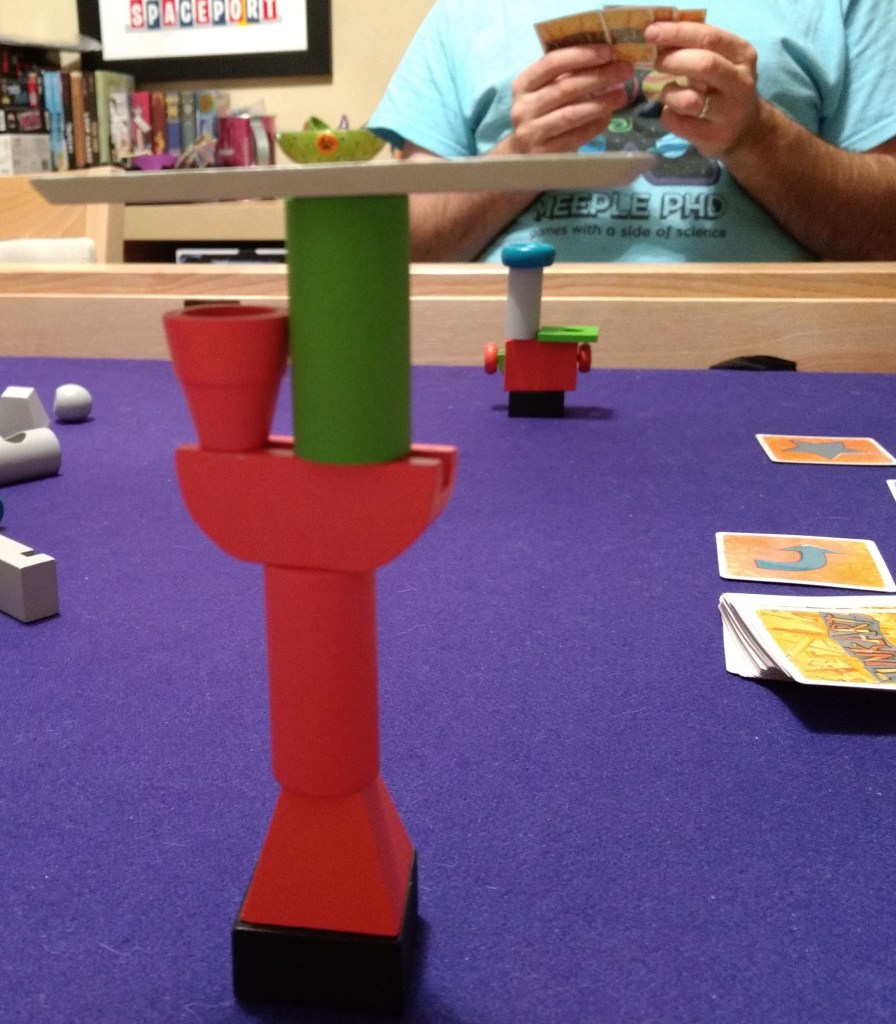We created beautiful sculptures by stacking pieces of junk in Junk Art, the next game in our A-Z game shelf play-through.

Basic Info: Junk Art
Players: 2-6
Time: 30 Minutes
Designers: Jay Cormier, Sen-Foong Lim
Artists: Philippe Guérin, Chris Quilliams
Publisher: Pretzel Games
Junk Art is a dexterity game where players take on the role of artists trying to gain fans in different cities by assembling oddly shaped pieces of wood one at a time onto carefully-balanced stacks. The specific rules for choosing pieces and winning fans varies by city, and will change with every game.

The game is set up with the 60 colored wooden pieces on the table and a number of city cards dealt face up (the rules suggests 3 cities, but the game can be made longer or shorter with more or fewer). The star card, direction of play card, fan tokens and deck of cards depicting the different wooden pieces all placed nearby.
Each city card represents one round of the game – and defines how the game will be played that round. In some rounds, each player will be building on their own sculpture, while in others, they build on a communal structure. In one round, players move seats each time they’ve played three pieces!

Similarly, the way the pieces are chosen (using the city cards) changes each round, depending on the city. In some, players draft cards from a hand. In others, players choose cards for other players to play. In some rounds, players are simply dealt a stack of cards they must play.
The rounds end differently depending on the city – some are based on a number of fallen pieces, while others are a race with the first player who finishes defining the end of a round.

Finally, the fans awarded each round ALSO depends on the city. Many cities give fans based on the tallest structure, though others are based on the number of pieces played on the structure. Still others award points to those players not eliminated from the round (for dropping too many pieces).
For example, in our game we played Philadelphia – the city of brotherly love. In that round, we each constructed our own sculpture. The round started with each player getting three cards. The player then chooses one card to keep, and gives the other two to the player on the right and left (or in the two-player game, both cards go to their opponent). The players take one piece at a time to add to their sculpture until all three are added. Once all players are done adding their three pieces, the process starts again. Players are eliminated from the round as soon as they have 2 or more fallen pieces, and the round ends when there’s just one player left OR when there aren’t enough cards to deal out three to each player. The last player standing receives 5 fans (or 3 fans each, if more than one player is left).

While some rules of the game change from city to city, there are a few constants. A player may only touch the “active” piece on their sculpture at any given time – the piece they are currently adding to the structure. If they want to move a previously played piece, it must be done by pushing it with the active piece. Players can use both hands, and are allowed to use one hand to hold their base. If the active piece falls, they’re allowed to pick it up and place it again, but other fallen pieces are handled according to the city rules.
Once players have finished all of their chosen cities, the game ends and the player with the most fans wins.

We picked this up about a year ago after trying it out at our local board game cafe. I had watched the Game Night play through and was intrigued by this different take on a stacking/dexterity game. Previously, I think Jenga was the only game I had played in this genre.
This is like the next step up dexterity game – I love the “game” around it. It’s not just about not knocking over your stack, but its about playing by the rules of the particular city for that round. In some cities, you aren’t penalized for dropped pieces (or, at least, for a single dropped piece), which can be hugely important when you have to place a terrible piece like the sphere. I will always play this if someone suggests it.

How is it as a 2-player game? Junk Art works well as a 2-player game. There’s one city that doesn’t work with just 2 players, but it’s marked, so you leave it out when you’re chosing cities to play.
How about the art and component quality? The wooden blocks are nice – though there are some irregularities from piece to piece. And some of the bases I have aren’t completely flat on every side, which adds a bit of challenge to the game. The shapes are all just frustrating enough to make the game interesting no matter which pieces you need to place. The cards are good quality, though I hate square cards – they’re hard to shuffle and harder to hold in your hand. But that’s a minor point, most of the game is in the wooden components.
Will this stay in my collection? This will definitely stay in my collection. I’m not as good at stacking games as I used to be, but I still enjoy playing them. I particularly like how different the different cities are throughout the game – each offers a different strategy and a different form of interaction with the other players.

